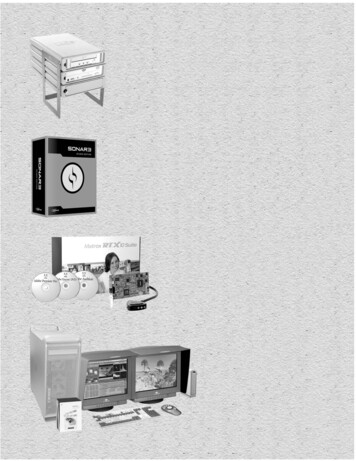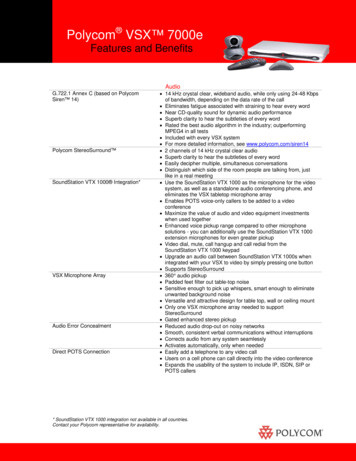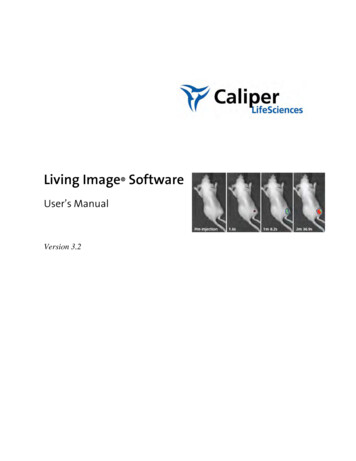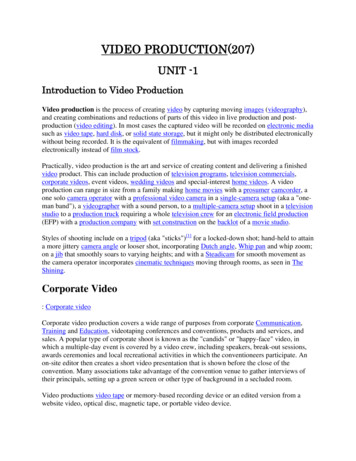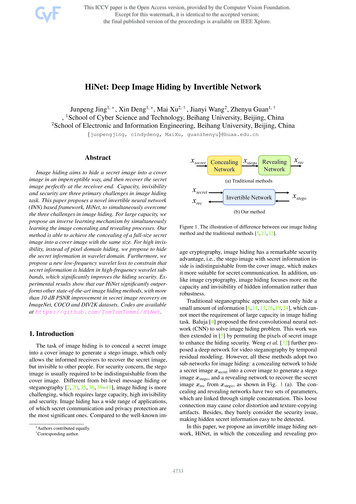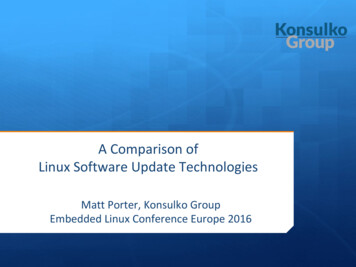
Transcription
IMAGE, VIDEO & 3DDATA REGISTRATION
IMAGE, VIDEO & 3DDATA REGISTRATIONMEDICAL, SATELLITE & VIDEOPROCESSING APPLICATIONSWITH QUALITY METRICSVasileios ArgyriouKingston University, UKJesús Martı́nez del RincónQueen’s University Belfast, UKBarbara VillariniUniversity College London, UKAlexis RocheSiemens Healthcare / University Hospital Lausanne / École Polytechnique FédéraleLausanne, Switzerland
This edition first published 2015 2015 John Wiley & Sons LtdRegistered officeJohn Wiley & Sons Ltd, The Atrium, Southern Gate, Chichester, West Sussex, PO19 8SQ, UnitedKingdomFor details of our global editorial offices, for customer services and for information about how to applyfor permission to reuse the copyright material in this book please see our website at www.wiley.com.The right of the author to be identified as the author of this work has been asserted in accordance withthe Copyright, Designs and Patents Act 1988.All rights reserved. No part of this publication may be reproduced, stored in a retrieval system, ortransmitted, in any form or by any means, electronic, mechanical, photocopying, recording orotherwise, except as permitted by the UK Copyright, Designs and Patents Act 1988, without the priorpermission of the publisher.Wiley also publishes its books in a variety of electronic formats. Some content that appears in printmay not be available in electronic books.Designations used by companies to distinguish their products are often claimed as trademarks. Allbrand names and product names used in this book are trade names, service marks, trademarks orregistered trademarks of their respective owners. The publisher is not associated with any product orvendor mentioned in this book.Limit of Liability/Disclaimer of Warranty: While the publisher and author have used their best effortsin preparing this book, they make no representations or warranties with respect to the accuracy orcompleteness of the contents of this book and specifically disclaim any implied warranties ofmerchantability or fitness for a particular purpose. It is sold on the understanding that the publisher isnot engaged in rendering professional services and neither the publisher nor the author shall be liablefor damages arising herefrom. If professional advice or other expert assistance is required, the servicesof a competent professional should be sought.Library of Congress Cataloging-in-Publication DataImage, video & 3D data registration : medical, satellite and video processing applications with qualitymetrics / [contributions by] Vasileios Argyriou, Faculty of Science, Engineering and Computing,Kingston University, UK, Jesús Martínez del Rincón, Queen’s University, Belfast, UK, BarbaraVillarini, University College London, UK, Alexis Roche, Siemens Medical Solutions, Switzerland.pages cmIncludes bibliographical references and index.ISBN 978-1-118-70246-8 (hardback)1. Image registration. 2. Three-dimensional imaging. I. Argyriou, Vasileios. II. Title: Image, videoand 3D data registration.TA1632.I497 2015006.6′ 93–dc232015015478A catalogue record for this book is available from the British Library.Cover Image: Courtesy of Getty imagesSet in 11/13pt, TimesLTStd by SPi Global, Chennai, India12015
22.12.22.32.4xixiiiIntroductionThe History of Image RegistrationDefinition of RegistrationWhat is Motion EstimationVideo Quality AssessmentApplications1.5.1 Video Processing1.5.2 Medical Applications1.5.3 Security Applications1.5.4 Military and Satellite Applications1.5.5 Reconstruction ApplicationsOrganization of the BookReferences11235557810111213Registration for Video CodingIntroductionMotion Estimation Technique2.2.1 Block-Based Motion Estimation TechniquesRegistration and Standards for Video Coding2.3.1 H.2642.3.2 H.265Evaluation Criteria2.4.1 Dataset2.4.2 Motion-Compensated Prediction Error (MCPE) in dB2.4.3 Entropy in bpp2.4.4 Angular Error in Degrees151516163030343535383940
34.4Objective Quality Assessment2.5.1 Full-Reference Quality Assessment2.5.2 No-Reference and Reduced-Reference Quality Metrics2.5.3 Temporal Masking in Video Quality 949Registration for Motion Estimation and Object TrackingIntroduction3.1.1 Mathematical NotationOptical Flow3.2.1 Horn–Schunk Method3.2.2 Lukas–Kanade Method3.2.3 Applications of Optical Flow for Motion EstimationEfficient Discriminative Features for Motion Estimation3.3.1 Invariant Features3.3.2 Optimization StageObject Tracking3.4.1 KLT Tracking3.4.2 Motion Filtering3.4.3 Multiple Object TrackingEvaluating Motion Estimation and Tracking3.5.1 Metrics for Motion Detection3.5.2 Metrics for Motion Tracking3.5.3 Metrics for Efficiency3.5.4 616264646466676868697070707575Face Alignment and Recognition Using RegistrationIntroductionUnsupervised Alignment Methods4.2.1 Natural Features: Gradient Features4.2.2 Dense Grids: Non-rigid Non-affine TransformationsSupervised Alignment Methods4.3.1 Generative Models4.3.2 Discriminative Approaches3D Alignment4.4.1 Hausdorff Distance Matching4.4.2 Iterative Closest Point (ICP)4.4.3 Multistage Alignment797980818183848688888989
Contentsvii4.590909091929494944.64.7Metrics for Evaluation4.5.1 Evaluating Face Recognition4.5.2 Evaluating Face Alignment4.5.3 Testing Protocols and Benchmarks4.5.4 te Sensing Image Registration in the Frequency DomainIntroductionChallenges in Remote Sensing ImagingSatellite Image Registration in the Fourier Domain5.3.1 Translation Estimation Using Correlation5.4 Correlation Methods5.5 Subpixel Shift Estimation in the Fourier Domain5.6 FFT-Based Scale-Invariant Image Registration5.7 Motion Estimation in the Frequency Domain for Remote Sensing ImageSequences5.7.1 Quad-Tree Phase Correlation5.7.2 Shape Adaptive Motion Estimation in the Frequency Domain5.7.3 Optical Flow in the Fourier Domain5.8 Evaluation Process and Related Datasets5.8.1 Remote Sensing Image Datasets5.9 Conclusion5.10 Exercise – 91506.76.8Structure from MotionIntroductionPinhole ModelCamera CalibrationCorrespondence ProblemEpipolar GeometryProjection Matrix Recovery6.6.1 TriangulationFeature Detection and Registration6.7.1 Auto-correlation6.7.2 Harris Detector6.7.3 SIFT Feature DetectorReconstruction of 3D Structure and Motion6.8.1 Simultaneous Localization and Mapping6.8.2 Registration for Panoramic View115116119120122123123124124
viiiContents6.9Metrics and Datasets6.9.1 Datasets for Performance Evaluation6.10 Conclusion6.11 Exercise – PracticeReferences15215415515515577.17.2Medical Image Registration MeasuresIntroductionFeature-Based Registration7.2.1 Generalized Iterative Closest Point Algorithm7.2.2 Hierarchical MaximizationIntensity-Based Registration7.3.1 Voxels as Features7.3.2 Special Case: Spatially Determined Correspondences7.3.3 Intensity Difference Measures7.3.4 Correlation Coefficient7.3.5 Pseudo-likelihood Measures7.3.6 General Implementation Using Joint HistogramsTransformation Spaces and Optimization7.4.1 Rigid Transformations7.4.2 Similarity Transformations7.4.3 Affine Transformations7.4.4 Projective Transformations7.4.5 Polyaffine Transformations7.4.6 Free-Form Transformations: ‘Small Deformation’ Model7.4.7 Free-Form Transformations: ‘Large Deformation’ ModelsConclusionExercise7.6.1 Implementation 171181184185186186187187188189193193195196Video Restoration Using Motion InformationIntroductionHistory of Video and Film RestorationRestoration of Video Noise and GrainRestoration Algorithms for Video NoiseInstability Correction Using RegistrationEstimating and Removing FlickeringDirt Removal in Video .28.38.48.58.68.7
Contentsix8.8 Metrics in Video Restoration8.9 Conclusions8.10 Exercise – PracticeReferences221225225225Index229
PrefaceThis book was motivated by the desire we and others have had to further the evolution of the research in computer vision and video processing, focusing on image andvideo techniques for registration and quality performance metrics. There are a significant number of registration methods operating at different levels and domains (e.g.block or feature based, pixel level, Fourier domain), each method applicable in specificdomains. Image registration or motion estimation in general is the process of calculating the motion of a camera and/or the motion of the individual objects composing ascene. Registration is essential for many applications such as video coding, tracking,object and face detection and recognition, surveillance and satellite imaging, structure from motion, simultaneous localization and mapping, medical image analysis,activity recognition for entertainment, behaviour analysis and video restoration.In this book, we present the state-of-the-art registration based on the targetedapplication providing an introduction to the particular problems and limitations ofeach domain, an overview of the previous approaches and a detailed analysis of themost well-known current methodologies. Additionally, various assessment metricsfor measuring the quality of registration are presented showcasing the differencesamong different targeted applications. For example, the important features in amedical image (e.g. MRI data) may be different from a human face picture, andtherefore, the quality metrics are adjusted accordingly. The state-of-the-art metricsfor quality assessment is analysed explaining their advantages and disadvantagesand providing visual examples. Also information about common datasets utilized toevaluate these approaches is discussed for each application.The evolution of the research related to registration and quality metrics has beensignificant over recent decades with popular examples including simple block matching techniques, optical flow and feature-based approaches. Also, over the last fewyears with the advent of hardware architectures, real-time algorithms have been introduced. In the near future, it is expected to have high-resolution images and videosprocessed in real time. Furthermore, the advent of new acquisition devices capturing new modalities such as depth require traditional concepts in registration and thequality assessment to be revised while new applications are also discussed.
xiiPrefaceThis book will provide: an analysis of registration methodologies and quality metrics covering the mostimportant research areas and applications; an introduction to key research areas and the current work underway in these areas; to an expert on a particular area the opportunity to learn about approaches in different registration applications and either obtain ideas from them, or apply his or herexpertises to a new area improving the current approaches and introducing novelmethodologies; to new researchers an introduction up to an advanced level, and to specialists, waysto obtain or transfer ideas from different areas covered in this book.
AcknowledgementsWe are deeply indebted to many of our colleagues who have given us valuable suggestions for improving the book. We acknowledge helpful advice from Professor TheoVlachos and Dr. George Tzimiropoulos during the preparation of some of the chapters.
1IntroductionIn the last few decades, the evolution in technology has provided a rapid development in image acquisition and processing, leading to a growing interest in relatedresearch topics and applications including image registration. Registration is definedas the estimation of a geometrical transformation that aligns points from one viewpoint of a scene with the corresponding points in the other viewpoint. Registration isessential in many applications such as video coding, tracking, detection and recognition of object and face, surveillance and satellite imaging, structure from motion,simultaneous localization and mapping, medical image analysis, activity recognitionfor entertainment, behaviour analysis and video restoration. It is considered one ofthe most complex and challenging problems in image analysis with no single registration algorithm to be suitable for all the related applications due to the extremediversity and variety of scenes and scenarios. This book presents image, video and3D data registration techniques for different applications discussing also the relatedquality performance metrics and datasets. State-of-the-art registration methods basedon the targeted application are analysed, including an introduction to the problemsand limitations of each method. Additionally, various assessment quality metrics forregistration are presented indicating the differences among the related research areas.For example, the important features in a medical image (e.g. MRI data) may not be thesame as in the picture of a human face, and therefore the quality metrics are adjustedaccordingly. Therefore, state-of-the-art metrics for quality assessment are analysedexplaining their advantages and disadvantages, and providing visual examples separately for each of the considered application areas.1.1 The History of Image RegistrationIn image processing, one of the first times that the concept of registration appeared wasin Roberts’ work in 1963 [1]. He located and recognized predefined polyhedral objectsImage, Video & 3D Data Registration: Medical, Satellite & Video Processing Applications with Quality Metrics,First Edition. Vasileios Argyriou, Jesus Martinez Del Rincon, Barbara Villarini and Alexis Roche. 2015 John Wiley & Sons, Ltd. Published 2015 by John Wiley & Sons, Ltd.
2Image, Video & 3D Data Registrationin scenes by aligning their edge projections with image projections. The first registration applied to an image was in the remote sensing literature. Using sum of absolutedifferences as similarity measure, Barnea and Silverman [2] and Anuta [3, 4] proposed some automatic methods to register satellite images. In the same years, Leese[5] and Pratt [6] proposed a similar approach using the cross-correlation coefficientas similarity measure. In the early 1980s, image registration was used in biomedical image analysis using data acquired from different scanners measuring anatomy.In 1973, for the first time Fischler and Elschlager [7] used non-rigid registration tolocate deformable objects in images. Also, non-rigid registration was used to aligndeformed images and to recognize handwritten letters. In medical imaging, registration was employed to aligned magnetic resonance (MR) and computer tomography(CT) brain images trying to build an atlas [8, 9].Over the last few years due to the advent of powerful and low-cost hardware,real-time registration algorithms have been introduced, improving significantly theirperformance and accuracy. Consequently, novel quality metrics were introducedto allow unbiased comparative studies. This book will provide an analysis of themost important registration methodologies and quality metrics, covering the mostimportant research areas and applications. Through this book, all the registrationapproaches in different applications will be presented allowing the reader to get ideassupporting knowledge transfer from one application area to another.1.2 Definition of RegistrationDuring the last decades, automatic image registration became essential in many imageprocessing applications due to the significant amount of acquired data. With the termimage registration, we define the process of overlaying two or more images of thesame scene captured in different times and viewpoints or sensors. It represents a geometrical transformation that aligns points of an object observed from a viewpoint withthe corresponding points of the same or different object captured from another viewpoint. Image registration is an important part of many image processing tasks thatrequire information and data captured from different sources, such as image fusion,change detection and multichannel image restoration. Image registration techniquesare used in different contexts and types of applications. Typically, it is widely used incomputer vision (e.g. target localization, automatic quality control), in remote sensing (e.g. monitoring of the environment, change detection, multispectral classification,image mosaicing, geographic systems, super-resolution), in medicine (e.g. combiningCT or ultrasound with MR data in order to get more information, monitor the growth oftumours, verify or improve the treatments) and in cartography updating maps. Imageregistration is also employed in video coding in order to exploit the temporal relationship between successive frames (i.e. motion estimation techniques are used to removetemporal redundancy improving video compression and transmission).
Introduction3In general, registration techniques can be divided into four main groups based onhow the data have been acquired [10]: Different viewpoints (multiview analysis): A scene is acquired from different viewpoints in order to obtain a larger/panoramic 2D view or a 3D representation of theobserved scene. Different times (multitemporal analysis): A scene is acquired in different times,usually on a regular basis, under different conditions, in order to evaluate changesamong consecutive acquisitions. Different sensors (multimodal analysis): A scene is acquired using different kindsof sensors. The aim is to integrate the information from different sources in orderto reveal additional information and complex details of the scene. Scene to model registration: The image and the model of a scene are registered. Themodel can be a computer representation of the given scene, and the aim is to locatethe acquired scene in the model or compare them.It is not possible to define a universal method that can be applied to all registrationtasks due to the diversity of the images and the different types of degradation andacquisition sources. Every method should take different aspects into account. However, in most of the cases, the registration methods consist of the following steps: Feature detection: Salient objects, such as close-boundary regions, edges, corners,lines and intersections, are manually or automatically detected. These features canbe represented using points such as centre of gravity and line endings, which arecalled control points (CPs). Feature matching: The correspondence between the detected features and the reference features is estimated. In order to establish the matching, features, descriptorsand similarity measures among spatial relationships are used. Transform model estimation: According to the matched features, parameters ofmapping functions are computed. These parameters are used to align the sensedimage with the reference image. Image resampling and transformation: The sensed image is transformed using themapping functions. Appropriate interpolation techniques can be used in order tocalculate image values in non-integer coordinates.1.3 What is Motion EstimationVideo processing differs from image processing due to the fact that most of theobserved objects in the scene are not static. Understanding how objects move helpsto transmit, store and manipulate video in an efficient way. Motion estimation isthe research area of imaging a video processing that deals with these problems, andit is also linked to feature matching stage of the registration algorithms. Motion
Image, Video & 3D Data Registration4A1BBAA2(a)Figure 1.1(b)(a) Occluded objects A1 and A2, (b) single object Aestimation is the process by which the temporal relationship between two successiveframes in a video sequence is determined. Motion estimation is a registration methodused in video coding and other applications to exploit redundancy mainly in thetemporal domain.When an object in a 3D environment moves, the luminance of its projection in 2Dis changing either due to non-uniform lighting or due to motion. Assuming uniformlighting, the changes can only be interpreted as movement. Under this assumption,the aim of motion estimation techniques is to accurately model the motion field. Anefficient method can produce more accurate motion vectors, resulting in the removalof a higher degree of correlation.Integer pixel registration may be adequate in many applications, but some problems require sub-pixel accuracy, either to improve the compression ratio or to provide a more precise representation of the actual scene motion. Despite the fact thatsub-pixel motion estimation requires additional computational power and executiontime, the obtained advantages settle its use that is essential for the most multimediaapplications.In a typical video sequence, there is no 3D information about the scene contents. The2D projection approximating a 3D scene is known as ‘homography’, and the velocityof the 3D objects corresponds to the velocity of the luminance intensity on the 2Dprojection, known as ‘optical flow’. Another term is ‘motion field’, a 2D matrix ofmotion vectors, corresponding to how each pixel or block of pixels moves. General‘motion field’ is a set of motion vectors, and this term is related to the ‘optical flow’term, with the latter being used to describe dense ‘motion fields’.Finding the motion between two successive frames of a video sequence is anill-posed problem due to the intensity variations not exactly matching the motion ofthe objects. Another problematic phenomenon is the covered objects, in which caseit is efficient to make the assumption that the occluded objects can be consideredas many separable objects, until they are observed as a single object (Figure 1.1).Additionally, in motion estimation, it is assumed that motion within an object issmooth and uniform due to the spatial correlation.
Introduction5The concept of motion estimation is used in many applications and is analysed inthe following chapters providing details of state-of-the-art algorithms, allowing thereader to apply this information in different contexts.1.4 Video Quality AssessmentThe main target in the design of modern multimedia systems is to improve the videoquality perceived by the user. Video quality assessment is a difficult task because manyfactors can interfere on the final result.In order to obtain quality improvement, the availability of an objective quality metric that represents well the human perception is crucial. Many methods and measureshave been proposed aiming to provide objective criteria that give accurate and repeatable results taking into account the subjective experience of a human observer. Objective quality assessment methods based on subjective measurements are using eithera perceptual model of the human visual system (HVS) or a combination of relevantparameters tuned with subjective tests [11, 12].Objective measurements are used in many image and video processing applicationssince they are easy to apply for comparative studies. One of the most popular metrics ispeak signal-to-noise ratio (PSNR) that is based on the mean square error between theoriginal and a distorted data. The computation of this value is trivial but has significantlimitations. For example, it does not correlate well with the perceived quality, and inmany cases the original undistorted data (e.g. images, videos) may not be available.At the end of each chapter, a description of the metrics used to assess the qualityof the presented registration methods is available for all the discussed applications,highlighting the key factors that affect the overall quality, the related problems andsolutions, and the examples to illustrate these concepts.1.5 Applications1.5.1 Video ProcessingRegistration techniques are required in many applications based on video processing.As mentioned in the earlier section, motion estimation is a registration task employedto determine the temporal relationship between the video frames. One of the mostimportant applications of motion estimation is in video coding systems.Video CODECs (COder/DECoder) comprise an encoder and a decoder. Theencoder compresses (encodes) video data resulting in a file that can be stored orstreamed economically. The decoder decompresses (decodes) encoded video data(whether from a stored file or streamed), enabling video playback.Compression is a reversible conversion of data to a format that requires fewer bits,usually performed so that the data can be stored or transmitted more efficiently. Thesize of the data in compressed form C relative to the original size O is known as the
6Image, Video & 3D Data RegistrationMotion vectorFigure 1.2 Motion estimation predicts the contents of each macroblock base due the motionrelative to the reference frame. The reference frame is searched to find the 16 16 block thatmatches the macroblockcompression ratio R O C. If the inverse of the process, ‘decompression’, producesan exact replica of the original data, then the compression is lossless. Lossy compression, usually applied to image and video data, does not allow reproduction of an exactreplica of the original data but results in higher compression ratios.Neighbouring pixels within an image or a video frame are highly correlated (spatial redundancy). Also neighbouring areas within successive video frames are highlycorrelated too (temporal redundancy).A video signal consists of a sequence of images. Each image can be compressedindividually without using the other video frames (intra-frame coding) or can exploitthe temporal redundancy considering the similarity among consecutive frames(inter-frame coding), obtaining a better performance. This is achieved in two steps:1. Motion estimation: A region (usually a block) of the current frame is comparedwith neighbouring region of the adjacent frames. The aim is to find the best matchtypically in the form of motion vectors (Figure 1.2).2. Motion compensation: The matching region from the reference frame is subtractedfrom the current region block.Motion estimation considers images of the same scene acquired in different time,and for this reason it is regarded as an image registration task. In Chapter 2, the mostpopular motion estimation methods for video coding are presented.Motion estimation is not only utilised in video coding applications but also toimprove the resolution and the quality of the video. If we have multiple, shiftedand low-resolution images, we can use image processing methods in order to obtainhigh-resolution images.Furthermore, digital videos acquired by consumer camcorders or high-speed cameras, which can be used in industrial applications and to track high-speed objects,are often degraded by linear space-varying blur and additive noise. The aim of video
Introduction7restoration is to estimate each image or frame, as it would appear without the effectsof sensor and optics degradations. Image and video/restoration are essential when wewant to extract still images from videos. This is because blurring and noise may notbe visible to the human eye at usual frame rates, but they can become rather evidentwhen observing a ‘freeze-frame’. The restoration is also a technique used when historical film materials are encoded in a digital format. Especially if they are encodedwith block-based encoders, many artefacts may be present in the coded frame. Theseartefacts are removed using sophisticated techniques based on motion estimation. InChapter 8, video registration techniques used in restoration applications are presented.1.5.2 Medical ApplicationsMedical images are increasingly employed in health care for different kinds of tasks,such as diagnosis, planning, treatment, guided treatment and monitoring diseases progression. For all these studies, multiple images are acquired from subjects at different times and in the most of the cases using different imaging modalities andsensors. Especially with the growing number of imaging systems, different types ofdata are produced. In order to improve and gain information, proper integration ofthese data is highly desirable. Registration is then fundamental in this integration process. One example of different data registration is the epilepsy surgery. Usually thepatients undergo various data acquisition processes including MR, CT, digital subtraction angiography (DSA), ictal and interictal single-photon emission computed tomography (SPECT) studies, magnetoencephalography (MEG), electroencephalography(EEG) and positron emission tomography (PET). Another example is the radiotherapy treatment, in which both CT and MR are employed. Therefore, it can be arguedthat the benefits for the surgeons are significant by registering all these data. Registering methods are also applied to monitor the growth of a tumour or to compare thepatient’s data with anatomical atlases.Motion estimation is also used for medical applications operating like a doctor’sassistant or guide. For example, motion estimation is used to indicate the right direction for the laser, displaying the optical flow (OF) during interstitial laser therapy(ILT) of a brain tumour. The predicted OF velocity vectors are superimposed on thegrey-scaled images, and the vectors are used to predict the amount and the directionof heat deposition.Another growing application of registration is in recognition of face, lips and feelings using motion estimation. A significant amount of effort has been put on signlanguage recognition. The motion and the position of the hand and the fingers are estimated, and patterns are used to recognize the words and the meanings (see Figure 1.3),an application particularly useful for deaf-mute people [13].The main problems of medical image data analysis and the application of registration techniques are discussed in details in Chapter 7.
Image, Video & 3D Data Registration8Figure 1.3Steps of hand and fingers
2 Registration for Video Coding 15 2.1 Introduction 15 2.2 MotionEstimationTechnique 16 . 7.4.6 Free-FormTransformations:'SmallDeformation'Model 188 . comprise an encoder and a decoder. The encoder compresses (encodes) video data resulting in a file that can be stored or streamed economically. The decoder decompresses (decodes) encoded .

